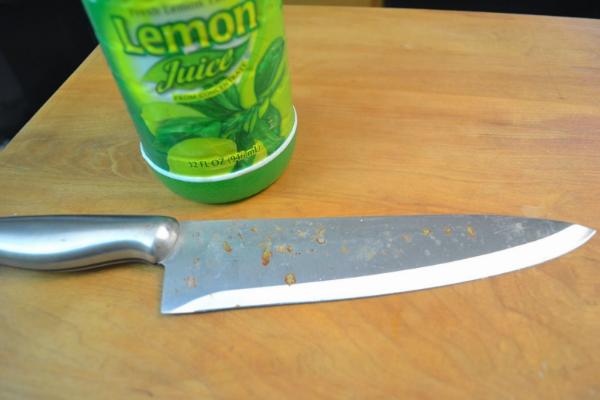As annoying as it is, seeing rust spots appear on your kitchen utensils is no picnic. The blades were described as stainless steel or “corrosion resistant” on the package. You may be asking what went wrong, what you can do to fix your knife, and how to avoid this problem in the future.
Your knives probably became wet when you placed them in the dishwasher or some other damp place. This situation exemplifies an ancient adage. Not stain “free” steel, but stain “less” steel. Carbon, water, and oxygen are the three elements necessary for rust to form.
Carbon is an element present in all steel knife blades. All of them have some quantity, though some have more than others. This is because it is the key element in hard, sharp blades. Sorry to be the bearer of bad news, but your kitchen knives should never go in the dishwasher.
Five Methods For Rusting Knives:

We don’t have much experience on this subject because we personally firmly feel that proper knife maintenance should begin on day one to prevent this from happening. However, as many of our readers find it to be a significant topic and an often-asked question, we’ve searched the internet for the best solutions.
These are popular techniques that people swear by and you can discover all over the internet. They are absurd, sensible, and all points in between. These techniques primarily apply to common stainless steel blades.
Always Remember:
Nevertheless, we must provide a warning before continuing. There are a lot of websites that suggest using steel wood to remove rust or balling up tin foil to remove rust stains from your blades. Proceed with cleaning a rusty knife that you would normally discard.
Please use these as a last resort if you’re trying to remove minor rust from an otherwise fine, pricey knife. When you apply too much pressure, they can and will cause scratches and/or additional damage to your knife.
Using Vinegar:

Teaching you how to use vinegar to remove rust from a knife is an easy undertaking. The most difficult thing to remember is to use white vinegar. That should, among other things, guarantee that it contains acetic acid, the component that combats rust.
However, there’s also the possibility that in certain situations, darker vinegar could even intensify the staining of the knife blades. Pour enough vinegar into a tall cup to completely cover the area of the blade that has rust spots on it. If the handles are not made of stainless steel, take care not to fill it up to the point where it cover them.
After letting the knife or knives stay there for about five minutes, remove them and use a sponge to remove the rust.
Baking Soda Technique:

Finding out how to use baking soda to remove rust from a knife is not hard. To make a paste, simply take a small amount of baking soda and combine it with a small amount of water. Using a toothbrush, liberally apply baking soda paste on the knife blade after cleaning it. To attempt to loosen up the rust spots, you should make sure to scrub extremely well in those areas.
Proceed to wipe the blade with a fresh cloth if it seems that you were able to remove the rust. If not, try scrubbing the knife with the toothbrush once more after leaving the baking soda on it for a while before cleaning it off.
The Method Of Using Lemon Juice:

With a few minor variations, the vinegar and lemon juice methods can be used to remove rust from knives. Once more, anyone can do this simple task at home with items they most likely already own.
First, pour half of the lemon juice into a tall glass. Whether it comes from a bottle or a freshly squeezed lemon makes no difference. Next, pour the remaining warm water from the tap into the glass.
With the blade down, of course, immerse your rusty knives in the lemon juice and let them sit for up to ten minutes. This should allow plenty of time for the corrosion sites to become less rigid. Take the knives out and use a sponge or scrub pad to clean the blades. Make sure to avoid using a pad that contains metal, since this may cause scratches on the blade. This ought to work if the rust is limited to the surface.
The Onion And Potato Methods:

This one sounds like a weird one. If you have a rusty knife in the kitchen, it’s worth a try.
Potatoes:
The oxalic acid found in potatoes works surprisingly well to remove rust from blades. This one involves stabbing a potato with a knife blade, letting it sit for a few hours, and then removing it and washing it off.
Onions:
Onions also contain sulphonic acids that can help remove rust from blades. When cutting onions, all you need to do is start sawing back and forth through the onion, allowing the friction created between the knife and the vegetable to do the work. This is supposed to aid with rust cleaning.
The Best Ways To Keep Your Knives From Rusting:
- Knowing what causes kitchen knives to rust in the first place is the surest method to spare yourself the trouble of cleaning them after each use. Following these guidelines will put you in the driver’s seat when it comes to keeping your blades from rusting.
- Always wipe down your knives right after each use for the greatest results. Until you have time to give them a proper cleaning, use a towel to wipe them dry.
- The ideal approach to clean kitchen knives is to wash them by hand in a solution of mild soap and warm water. Before anything else, make sure they’re completely dry and put them somewhere dry.
- Steer clear of the dishwasher it will soak your utensils for hours and probably has a steam cycle that will ruin them. Those who often leave things in there overnight are particularly vulnerable to this. Please, just don’t. To preserve your pricey knives from harm, washing them by hand isn’t hard and is worth the effort. One of the most common types of knives that end up in the dishwasher is the steak knife. Even while it’s not something we advocate, you can safely put steak knives in the dishwasher if the manufacturer says so.
- There are some good reasons why you should never wet your blades. The first is corrosion on the blades, and the second is harm to the handles, particularly wooden ones.
- Be sure to keep your knives in a dry place when not in use. Keeping your knife blocks damp will shorten their lifespan. Consider investing in a magnetic knife holder for convenient storage if you do not already own one.
FAQs:
How Can One Remove Rust From A Knife?
Vinegar and lemon juice are common cleaning agents because of their acidity, which can remove rust. Soaking the blade in vinegar or scrubbing it with lemon and salt are straightforward ways to clean knives that don’t have much rust. Rust erasers are great for cleaning pocket knives or blades that are severely rusted.
What Is The Best Way To Use Baking Soda To Clean A Rusted Knife?
The process of removing rust from a knife using baking soda is straightforward. Simply combine a small amount of baking soda with water to form a paste. Use a toothbrush to generously coat the knife blade with baking soda paste after you’ve cleaned it.
Is There A Way To Clean A Rusted Knife?
Because grime might impede the process of rust removal, it is imperative that you first clean the blade of your knife. Because water is the main culprit in your knife’s rust, it’s best to keep it away from water. The alternative is to use a cleaning solution and a cloth to wipe it down. 2) Make a Paste using Baking Soda Make a little amount of baking soda paste next.
Conclusion:
Though you are now knowledgeable of the process of rust removal, it does not imply that you should allow your blades to rust. The goal should remain prevention. You might have to rethink your expectations if you’re hoping to keep your blade in perfect condition indefinitely.
As long as there is no neglect involved, you should welcome the character changes that occur to your knife over time. The worth of a knife, like that of an old truck, increases with use and time.

